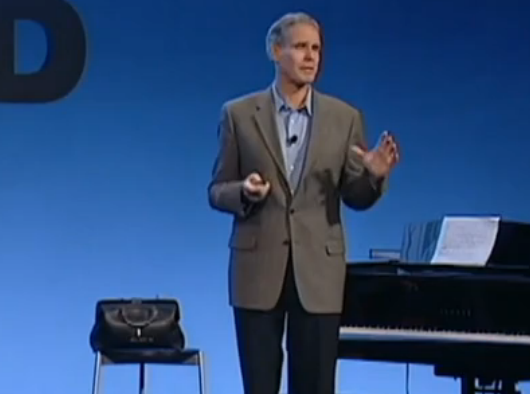(单词翻译:单击)
听力文本
But of course we have a way to measure that now on a continuous basis, with a sensor that detects blood glucose,
当然现在我们已经有方法可以连续监控它了,方法是用一个传感器来连续检测血糖浓度,
and it's important because we could detect hyperglycemia that otherwise wouldn't be known, and also hypoglycemia.
这很重要,因为通过检测可以确定我们自己不知道的高血糖症或低血糖症。
And you can see the red dots, in this particular patient's case, were finger sticks, which would have missed both ends.
你可以看到,这个病例中的红点是不连续数据,它遗漏了很多居于两端的数据。
But by continuous monitoring, it captures all that vital information.
但是由于持续的监控,我们可以获得所有的重要信息。
The future of this though, is being able to move this to a Band-Aid type phenomenon, and that's not so far away.
这一技术的未来是要能把监控设备做得像创可贴一样简易,而且这也即将得以实现。
So, let me just give you, very quickly, 10 top targets for wireless medicine.
下面,让我来简略地介绍无线医疗的十大目标。

All these things are possible -- some of them are very close, or already, as you heard, are available today, in some way or form.
所有这些都是能够实现的,有些已经非常接近了,或者如你所知已经以某种形式或方式存在了。
Alzheimer's disease: there's five million people affected, and you can check vital signs, activity, balance.
老年痴呆症:我们有500万人患有老年痴呆症,大家可以检查生命体征、活动以及身体各项均衡来进行监测。
Asthma: large number, we could detect things like pollen count, air quality, respiratory rate.
哮喘:患者众多,你也可以通过检测花粉、空气质量、呼吸率来有效控制。
Breast cancer, I'll show you an example of that real quickly.
乳腺癌,稍后我将给诸位展示一个例子。
Chronic obstructive pulmonary disease. Depression, there's a great approach to that in mood disorders.
慢性阻塞性肺病。忧郁症,我们现在有了监控情绪是否异常的好方法。
Diabetes I've just mentioned. Heart failure we already talked about.
糖尿病、心力衰竭我刚才已提到。
Hypertension: 74 million people could have continuous blood-pressure monitoring to come up with much better management and prevention.
然后就是高血压,7400万的人可以通过持续监控来来很好的控制和预防高血压。
And obesity we already talked about, the ways to get to that. And sleep disorders.
肥胖症和睡眠异常,也可以通过这样的方法来控制。
演讲介绍
EricTopol说,我们很快就可以通过智能手机来监控我们的生命体征并监测一些慢性疾病。在TEDMED上,他着重介绍了应用在未来医疗上的一些重要无线装置,这些装置可以帮助我们远离医院的病床。


